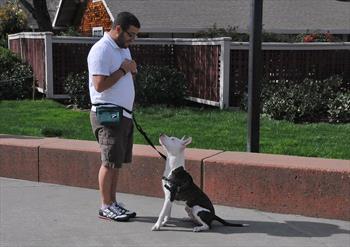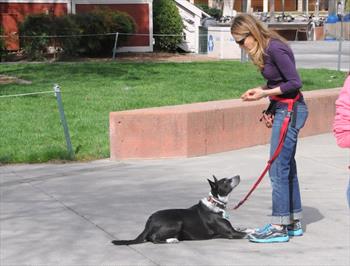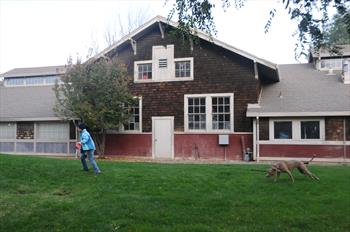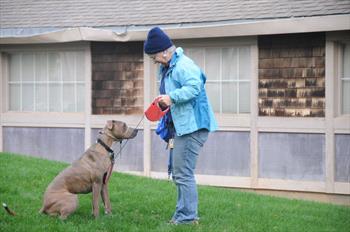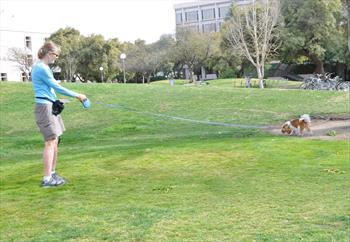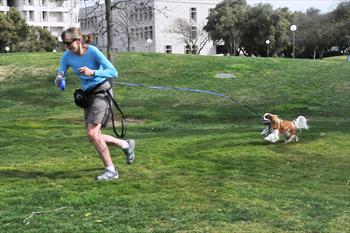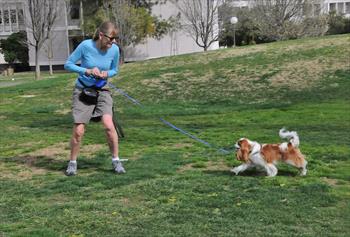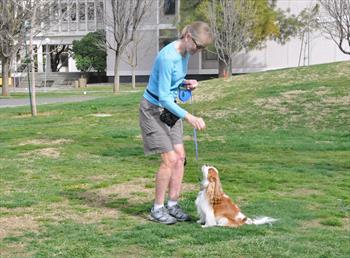If you’re like the general population, your dog has a decent or so-so come when called in the house, but outside in the yard or at the park, you might experiences something like this:
“My dog doesn’t really like to run to me when I call her,” says one reader of this blog. “She prefers to search for food and find things than run around at the park. I’m too nervous to let her off leash because her recall is not good yet.”
This reader has the right idea. She’s keeping her dog on a long leash at the park but is at a loss at what to do next. Says the owner, “I do use toys and very tasty food and call her before she goes very far (on the long line), but she acts deaf and is very focused elsewhere. On occasion, she completely ignores me, and I wonder what to do in that situation – do I reel her in using the long line and treat her, or ignore it and try recalling her again in a couple of minutes?”
The come when called is important enough that we actually have a 3-session class just for that, because to actually train a reliable recall with distractions, you have to train in stages.
Step 1: Train the dog to first focus on you in non-distracting situations and then in the more distracting situation. If you can’t first get them to focus on you and think you’re fun, they’re not likely to come running when you call. They’re more likely to go running towards the dog or the tree, or the fire-hydrant with the lovely scent.
Step 2: Next, we add more speed and distance to increase the fun. Watch this video to see the steps for training a focused, fun sit and then adding speed to make it fun. The clear body movement and direction of the handler are important factors for getting good attention and focus from the dog. The dog’s learning it’s fun to run and keep up with you and then to sit and focus on you. You’ll be able to convert this into a come when called.
Note that some dogs will need to go through the Learn to Earn program in order to develop focus inside and then outside, then outside in distracting situations. So, if you’re having any problems, it’s time to try the Learn to Earn protocol.
Step 3: Practice come when called on a long leash. This is the only time I use a retractable leash. In this step, practice in an environment where you and your dog are good at steps 1 and 2. Then, put your dog on a retractable leash and let him wander around and sniff. Then, randomly call him and immediately turn and run the other way while giving a clear directional tug on the leash so he knows you want him to follow. The goal is that you run far enough and fast enough so that he gets the message that the “fun is in your direction” and start running full speed. Then, turn around so that you’re paying attention to him and he doesn’t get to run by. Make sure that you’re letting the leash retract so that there’s no slack as he gets closer to you. Then when he catches up to you, he should automatically sit to get treats. Reward one time for coming and sitting and additionally for remaining seated. Use praise if his body language shows that he likes it.
In class we start in the regular training area and as the dog-owner teams develop a good recall in that area we move to areas where they have never been and add more distractions such as by having dogs play fetch nearby.
On our last class, we practice on a country walk where owners practice come when called about 20 times during the walk. In each new environment, we make sure the dog will focus well on the sit and repeat sit games before we let the dog roam on the retractable leash. Once dogs consistently come when called at a dead run right when they hear the words “Rover Come!” the owners can let the dogs drag a long, light line in a dog safe area until they are comfortable that the dog is 100% in that type of environment. Remember to bring extra yummy treats every time and to make it fun by calling in a happy voice and running the other way. With consistency you’ll be pleasantly surprised faster than you think!


